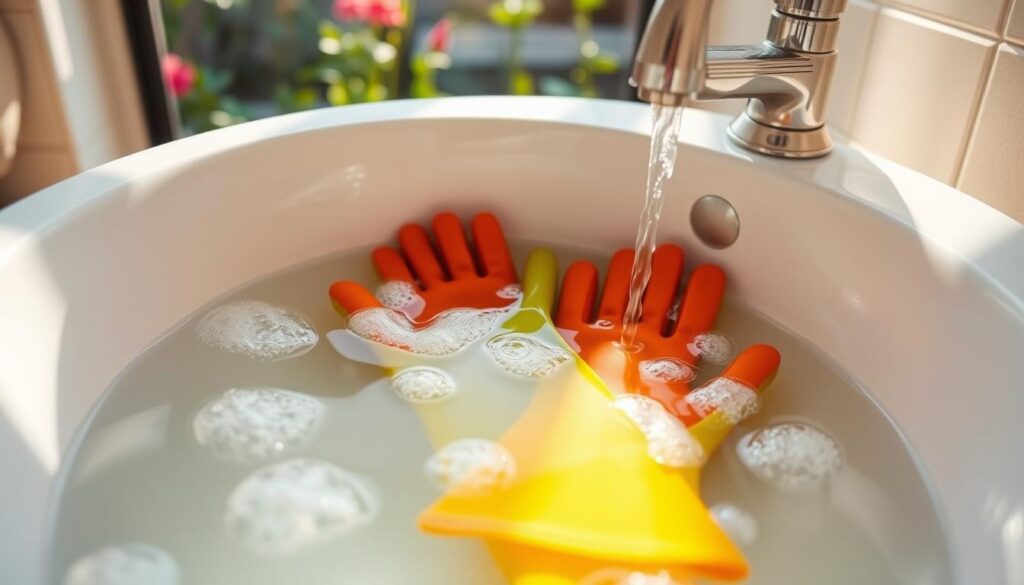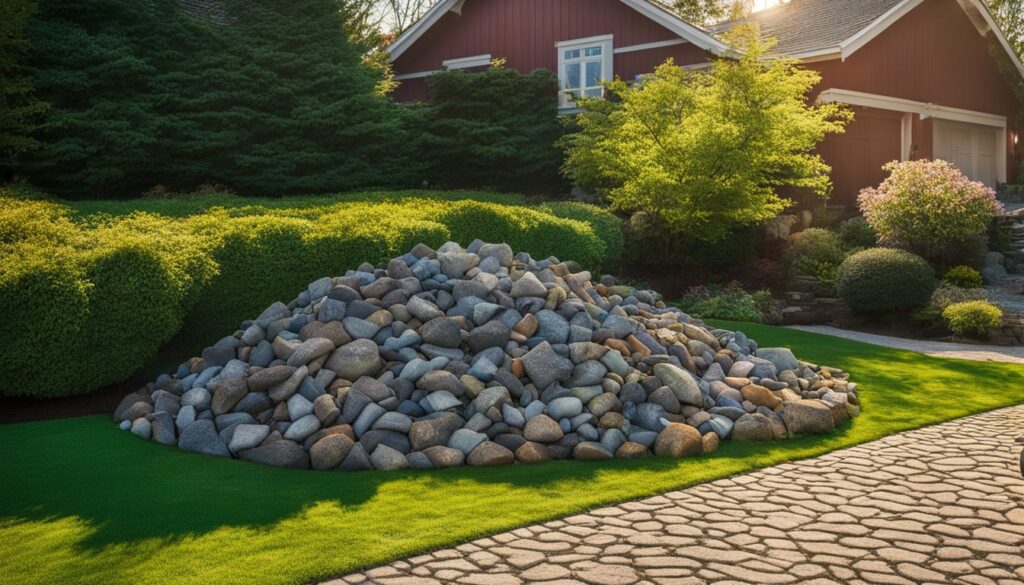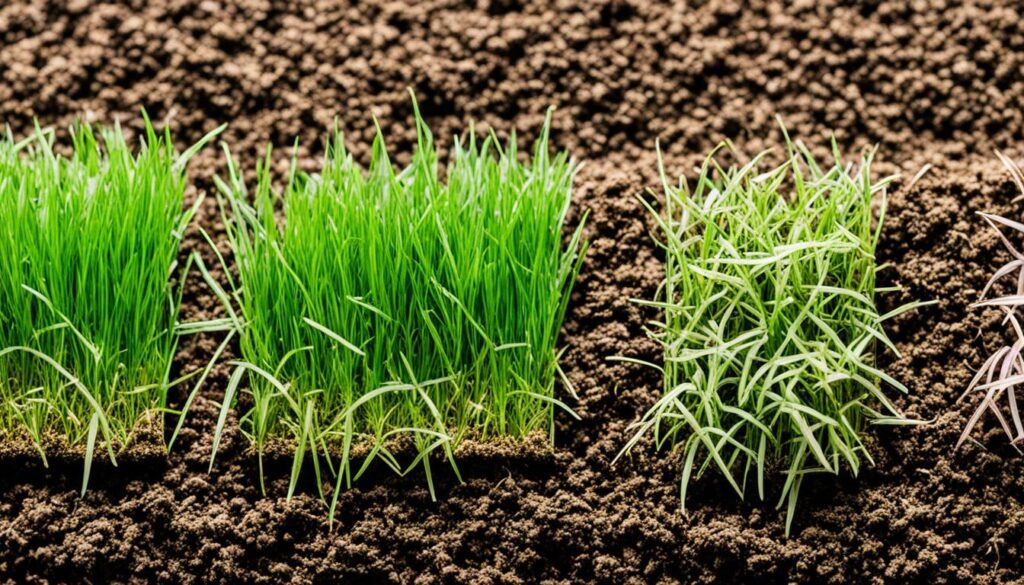Cleaning gardening gloves is not just about looks; it’s also key to keeping your garden safe. Gloves used for handling soil, chemicals, or sick plants can carry germs. By learning how to wash them right, I can make my gloves last longer and keep my gardening clean.
Knowing which gloves need special care makes the process easier. This way, I can take good care of my gloves and enjoy gardening more.
Key Takeaways
- Washing frequency should depend on the level of dirt accumulation.
- Cotton and canvas gloves can typically be machine washed with mild detergent.
- Rubber and latex gloves require gentle hand washing to maintain quality.
- Leather gloves need special care, including conditioning to maintain flexibility.
- Air drying gloves helps prevent mildew growth and extends their lifespan.
- Using baby powder can effectively eliminate odors after washing gloves.
- Follow manufacturer instructions for specific care guidelines for your gloves.
The Importance of Cleaning Gardening Gloves
Cleaning gardening gloves is key for keeping gardening clean and safe. Dirty gloves can carry bacteria from sick plants to our skin. Washing them often keeps them in good shape and makes them last longer.
Gloves protect us from cuts, scrapes, and harmful chemicals. Keeping them clean is crucial for safety and good gardening.
Adding proper cleaning to my gardening routine is important. It keeps my gloves clean and safe from dirt. This makes gardening safer and cleaner.
For more tips on caring for gloves, check out some gardening tips. They show how washing gloves regularly is beneficial.
| Type of Gloves | Cleaning Frequency | Cleaning Method |
|---|---|---|
| Cotton/Fabric | After every use | Machine wash with cold water |
| Leather/Suede | Weekly | Spot clean and condition |
| Latex/Rubber/Nitrile | After every use | Rinse and sanitize |
Following these tips makes my gloves last longer. It also keeps my hands safe and healthy while gardening.
Understanding Different Types of Gardening Gloves
In my gardening journey, I’ve learned that picking the right gloves is key for safety and comfort. There are many types of gloves for different needs. You can choose from cotton, rubber, and leather gloves, each with its own benefits.
Cotton gloves are great for light gardening. They keep my hands cool and protect against minor cuts and dirt. They’re light and popular, but not as durable as other materials.
For tough gardening jobs, rubber or nitrile gloves are essential. They’re waterproof and protect against chemicals. This makes them perfect for handling fertilizers and pesticides. A good pair lets me work without worrying about skin damage.
Leather gloves are my choice for heavy-duty tasks. They shield my hands from thorns and sharp objects. They cost more, but they last a long time, making them worth the investment.
Gloves come in sizes for both men and women, ensuring a good fit. Sizes range from small to XXX large, fitting different hand sizes. There are gloves for specific gardening tasks, helping both beginners and experts.
Many gardeners wear gloves to protect against blisters, cuts, and infections. Not everyone likes wearing them, though. Finding the right balance between comfort and safety is important, especially with tough plants.
| Type of Gloves | Material | Best For | Durability | Protection Level |
|---|---|---|---|---|
| Cotton Gardening Gloves | Cotton | Light gardening tasks | Medium | Low |
| Rubber Gardening Gloves | Rubber | Waterproof tasks | High (5 years) | Medium to High |
| Leather Gardening Gloves | Leather | Heavy-duty work | High (long-lasting) | High |
| Nitrile Gloves | Nitrile | Chemical exposure | High (5 years) | Medium to High |
Cleaning Cotton Gardening Gloves
Cotton gardening gloves need regular care to stay durable and functional. Cleaning them is easy. First, I rinse off the dirt under a garden hose while wearing them. Then, a soft-bristled brush helps remove tough dirt.
Next, I soak the gloves in cold water with laundry detergent for 10 minutes. I focus on the cuffs and seams, where dirt tends to gather. After soaking, I wash them on a gentle cycle to keep them safe.
Cotton glove care is key during maintenance. After washing, I air dry them. This method prevents shrinkage and keeps them ready for gardening.
| Step | Action |
|---|---|
| 1 | Rinse surface dirt with a garden hose. |
| 2 | Use a soft-bristled brush for stubborn dirt. |
| 3 | Soak in cold water with laundry detergent for 10 minutes. |
| 4 | Wash on a gentle cycle. |
| 5 | Air dry completely to avoid shrinkage. |
By following these cleaning steps, my gardening gloves stay reliable for outdoor tasks.
Cleaning Rubber and Nitrile Gloves
Cleaning rubber gardening gloves, including those made from nitrile, is easy because they’re waterproof. I often wash them while still wearing them. Using soap or dishwashing liquid, I can easily clean away dirt and grime. For tough stains, a soft-bristled brush helps a lot.
After cleaning, it’s important to rinse both sides under cold water. This removes soap and keeps the gloves in good shape. I always air-dry the gloves to avoid mildew. Taking good care of nitrile gloves makes them last longer and keeps them ready for gardening.
To summarize the key steps for cleaning rubber gloves, here’s a simple table:
| Step | Description |
|---|---|
| 1 | Put on gloves and apply soap or dishwashing liquid. |
| 2 | Gently scrub the gloves with a soft-bristled brush. |
| 3 | Rinse the gloves under cold water to remove soap. |
| 4 | Air-dry the gloves to prevent mildew formation. |
By following these steps, I keep my gloves clean after using chemicals or touching sick plants. This keeps my garden safe. Regular cleaning also makes sure my gloves stay strong and protective for the next time I garden.
Leather Gardening Gloves: Best Practices
Keeping my leather gardening gloves in good shape is key to their lasting long and working well. Cleaning them right helps protect my investment and keeps them in top condition. It’s important to take care of them regularly to avoid damage over time.
Removing Debris from Leather Gloves
First, I remove any dirt or debris from the gloves with a soft-bristled brush. If they’re wet or muddy, I let them dry fully before cleaning. This method keeps the leather safe while removing dirt and grime. It’s crucial to be gentle to prevent any damage to the leather.
Conditioning Leather After Cleaning
After cleaning, I condition my leather gloves. I use saddle soap or a good leather conditioner on slightly damp gloves. This keeps them soft and protects them from future harm. I spread the conditioner evenly and let the gloves air-dry in a place away from the sun. Regular conditioning keeps them flexible and extends their life, making it a key part of their care.
Washing Techniques for Different Materials
Each type of gardening glove needs its own washing method. Knowing how to wash washing techniques for gardening gloves can make them last longer. I sort gloves into three main types: cotton, rubber, and leather.
Cotton Gloves: Cotton gloves are a favorite, chosen by 67% of gardeners for their comfort and flexibility. To clean them, use cold water and regular detergent. I either machine wash or hand wash them gently to keep the fibers strong.
Rubber Gloves: Rubber gloves can handle tough cleaning. I clean them with warm soapy water and scrub hard to remove dirt. These gloves are known for their toughness and staying dry.
Leather Gloves: Leather gloves need special care. Washing them too much can make them stiff or shrink. I clean them with a damp cloth instead of a machine. It’s important to skip bleach and cleaners with alcohol, as they can make leather brittle. To keep them soft, I use oils like olive or neatsfoot oil.
Knowing how to take care of each glove type is key. Regular cleaning stops stains from setting in. This keeps my gardening gloves looking good and working well.
| Glove Material | Preferred Washing Method | Care Tips |
|---|---|---|
| Cotton | Machine or hand wash with cold water | Use regular detergent, avoid hot water |
| Rubber | Scrub with warm soapy water | Rinse thoroughly, air dry |
| Leather | Wipe with damp cloth | Moisturize with olive or neatsfoot oil |
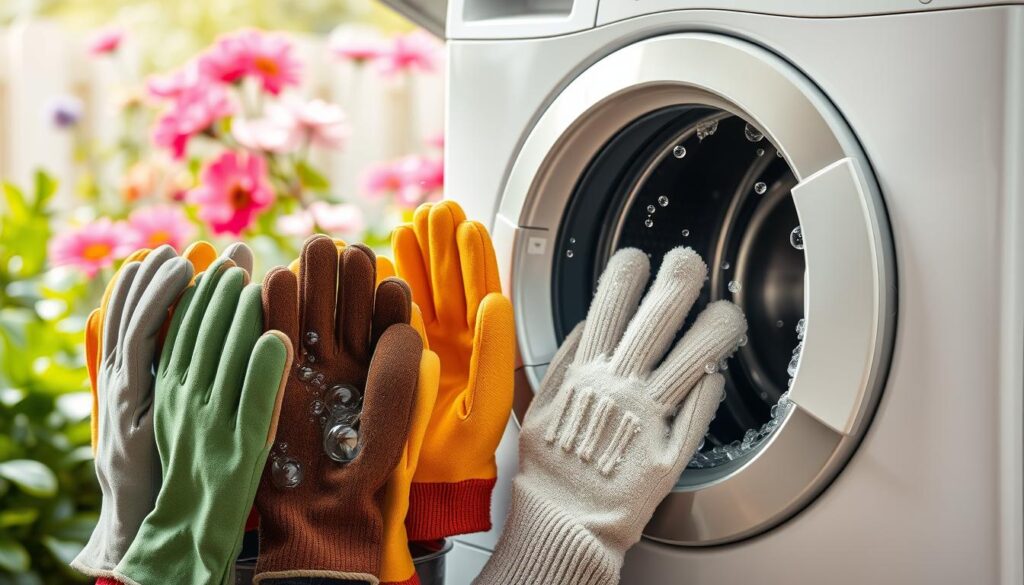
Can You Put Gardening Gloves in the Washing Machine?
Have you ever wondered, can you put gardening gloves in the washing machine? It really depends on the glove’s material. Cotton gloves are usually safe to wash in a machine. But, rubber gloves, like those made from latex or nitrile, need gentle care to avoid damage.
Leather gloves should never go in the washing machine. They might shrink or lose their color. I clean them with special leather care methods instead. For all gloves, cold water is best to prevent damage. A gentle or hand-wash setting on the machine is perfect for keeping the gloves in good shape.
Choosing the right detergent is key for cleaning gloves. Regular laundry detergent, soap, or dishwashing liquid works well to remove dirt. After washing, it’s important to air-dry them. This keeps the gloves from losing their shape and prevents mildew.
I always wash rubber gloves used for handling chemicals separately. This stops them from getting mixed with other gloves.
| Material | Can be Machine Washed? | Washing Method | Drying Method |
|---|---|---|---|
| Cotton | Yes | Gentle cycle, cold water | Air-dry |
| Rubber/Nitrile | Yes (gentle) | Cold water, gentle cycle | Air-dry |
| Leather | No | Hand wash with leather soap | Air-dry |
| PVC | No | Hand wash with mild detergent | Air-dry |
Knowing what your gardening gloves are made of helps you choose the best way to clean them. Whether you can machine wash them or need to hand wash makes a big difference. It helps your gloves last longer.
How to Pre-Treat Stains on Gardening Gloves
Gardening gloves often get stained from soil, plant sap, or chemicals. To pre-treat these stains, apply a bit of laundry detergent directly to the stain. Let it sit for about 10 minutes to work into the fibers. This step is key for removing stains when you wash the gloves later.
For tough stains, a gentle scrub brush can help. Rub the stain in circles to get the detergent deep into the fabric. Then, rinse the gloves with cold water to get rid of any leftover detergent. This approach not only removes stains but also keeps the gloves in good condition, making them last longer.
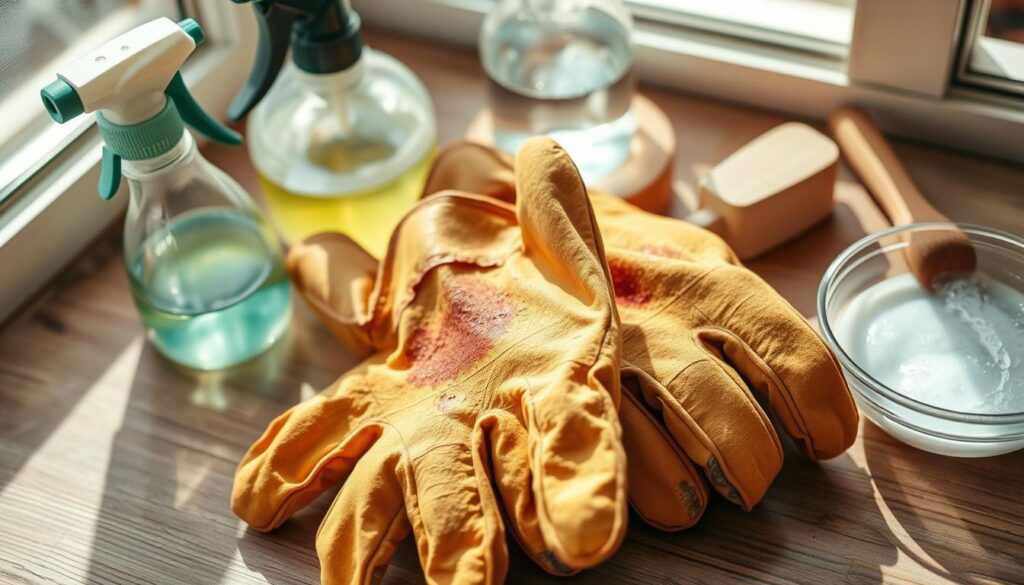
Drying Gardening Gloves Safely
After washing my gardening gloves, it’s key to dry them well to avoid mold and mildew. I like to air-dry them for the best outcome. Using a clothes drying rack or hanging them outside works great. It’s smart to hang my gloves upside down to help water drain and improve airflow.
Staying away from heat is crucial. High temperatures can change the shape of the gloves and reduce their protection. By air-drying, I keep my gloves in good shape and make them last longer. Many people don’t dry their gloves right, which can lead to health issues.
Learning how to dry gardening gloves right makes gardening more efficient and keeps it clean. I often look at resources like this one for tips on washing and caring for my gloves. Following these steps protects my hands and helps my gloves last longer.
Storage Tips for Clean Gardening Gloves
Storing gardening gloves right is key to making them last longer. I keep them in a dry, airy spot to stop mildew from growing. Just throwing them in a drawer isn’t enough. I prefer methods that let air get to them. Hanging them or using bags with holes helps keep them fresh.
With the average American woman having about seven pairs of garden gloves, finding good storage is smart. A shoebox is perfect for storing seven pairs. It keeps my gloves tidy and ready to use when I need them.
Checking my gloves often is part of keeping them in good shape. Before each gardening trip, I look for any damage. Using worn-out gloves can hurt my hands or let in harmful substances. By taking care of and storing my gloves right, they stay in great shape all season.
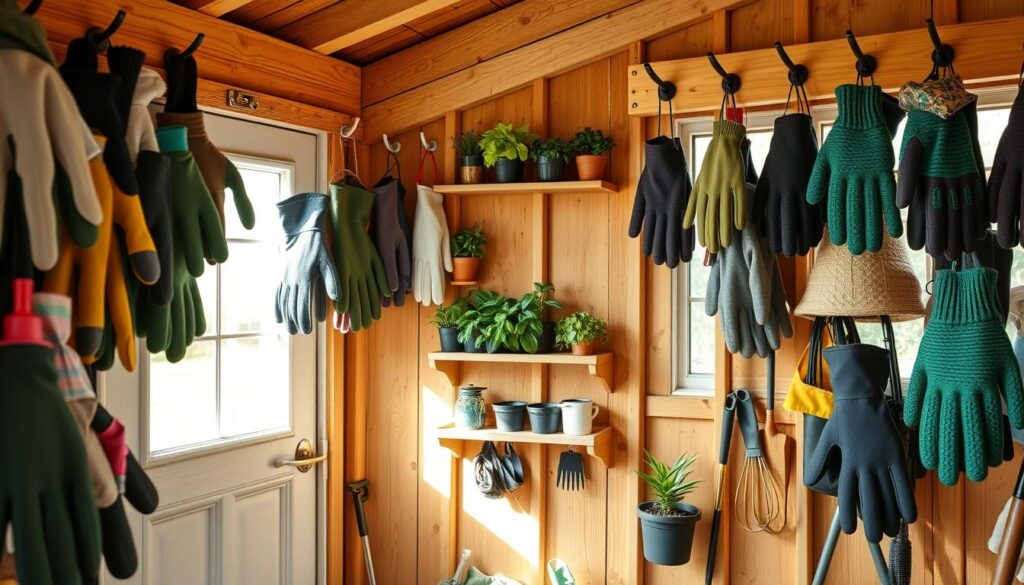
Conclusion
Learning how to take care of gardening gloves is key for garden lovers. It’s vital to know how to keep these gloves in good shape. They protect our hands from thorns, cuts, and dirt while we work in the garden.
Washing them right is important, depending on the material. Hand washing or using the washing machine can make them last longer. This keeps them in top condition for future use.
Also, a good fit is crucial. It helps with performance and makes it easier to do various gardening tasks. Whether it’s heavy work with leather gloves or light tasks with cotton, a proper fit is essential.
Finally, drying and storing gloves properly keeps them ready for the next time. This ensures they stay in great shape. By taking care of my gloves, I can also keep my garden healthy by reducing disease spread between plants.
FAQ
Why is it important to clean my gardening gloves?
Cleaning gardening gloves is key for keeping them fresh and safe. It stops diseases from spreading from soil and plants. Washing them often keeps my hands safe and makes the gloves last longer.
What are the different materials used for gardening gloves?
Gardening gloves are made from leather, cotton, rubber, nitrile, and synthetic blends. Leather is strong, cotton lets air in, and rubber and nitrile keep water out.
Can I machine wash my gardening gloves?
Machine washing depends on the glove material. Cotton gloves are okay in the machine, but leather and PVC need hand washing. Nitrile gloves can be washed gently and dried in the air.
How should I clean my cotton gardening gloves?
To clean cotton gloves, rinse off dirt under a garden hose while wearing them. For tough dirt, use a soft brush. Then, soak them in cold soapy water for ten minutes and let them air dry.
What is the best way to clean rubber and nitrile gardening gloves?
Rubber and nitrile gloves are easy to clean because they’re waterproof. Wash them on while wearing with soap or dish soap, then rinse under cold water. Always air dry them to avoid mildew.
How do I properly maintain my leather gardening gloves?
For leather gloves, brush off dirt first. Clean them with saddle soap or a conditioner to keep the leather soft. Let them dry in the air, away from sunlight.
What techniques should I use for washing gloves of different materials?
Washing gloves needs special care. Cotton gloves go in cold water with regular detergent. Rubber gloves can be cleaned more thoroughly. Leather gloves should be hand washed to avoid damage.
How can I pre-treat stains on my gardening gloves?
To treat stains, apply laundry detergent directly to the stain and wait ten minutes. Then, gently scrub with a soft brush to help the detergent work better during washing.
What is the best way to dry my gardening gloves after washing?
Let your gloves air dry for the best results. Hang them upside down on a drying rack to help water drain out. Keep them away from heat to prevent damage.
What are some storage tips for my clean gardening gloves?
Store your gloves in a dry place with good airflow to avoid mildew. Use hanging or ventilated bags to keep air moving. Check them often for any signs of wear.

